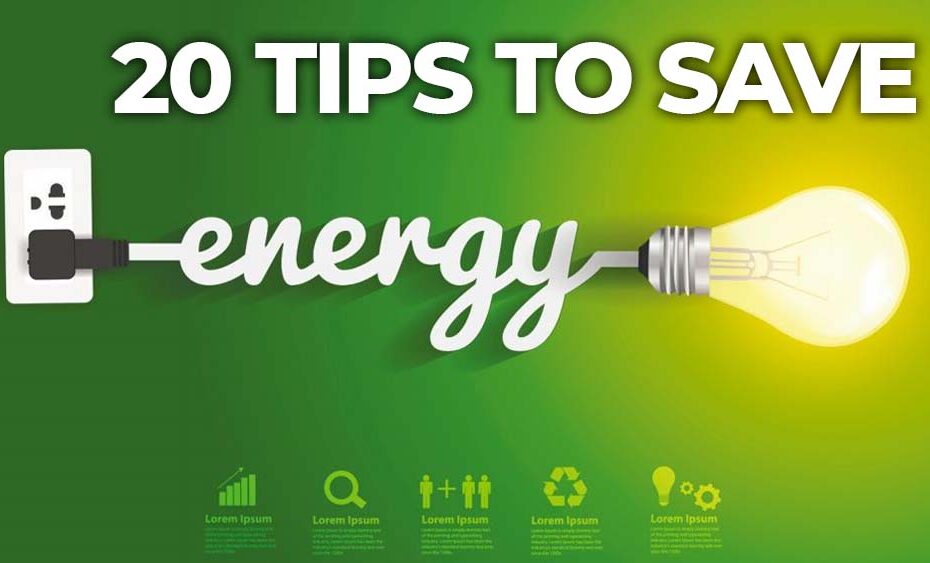Here are 20 energy saving tips that anyone can implement at home. In today’s world, energy efficiency is more than just a buzzword—it’s a necessity. Not only does saving energy reduce your carbon footprint, but it also cuts down on your utility bills. Here are 20 practical tips to make your home more energy-efficient.
1. Switch to LED Lighting
LED bulbs use up to 75% less energy and last 25 times longer than incandescent lighting. Make the switch to reduce your lighting costs significantly.
2. Use Smart Thermostats
Invest in a smart thermostat that automatically adjusts the temperature based on your schedule and preferences. This can save up to 10-15% on heating and cooling bills.
3. Seal Air Leaks
Inspect your home for drafts and seal gaps around windows, doors, and other openings with weatherstripping or caulk to prevent heat loss.
4. Upgrade Insulation
Proper insulation in your attic, walls, and floors can save up to 20% on heating and cooling costs by keeping your home’s temperature stable.
5. Install Energy-Efficient Windows
Energy-efficient windows can reduce heating and cooling costs by up to 30% by minimizing heat loss in the winter and heat gain in the summer.
6. Use Ceiling Fans
Ceiling fans can help circulate air, reducing the need for heating and cooling. In the winter, reverse the direction to push warm air down.
7. Utilize Natural Light
Open blinds and curtains during the day to take advantage of natural light, reducing the need for artificial lighting.
8. Unplug Devices
Even when turned off, many devices consume energy if left plugged in. Unplug chargers, appliances, and electronics when not in use, or use power strips to easily switch them off.
9. Opt for Energy-Efficient Appliances
Look for the ENERGY STAR label when purchasing new appliances. These models use significantly less energy and water than their conventional counterparts.
10. Regularly Maintain HVAC Systems
Keep your heating and cooling systems running efficiently by changing filters regularly and scheduling annual maintenance checks.
11. Install Low-Flow Fixtures
Low-flow showerheads and faucets reduce water usage and the energy required to heat the water, lowering both water and energy bills.
12. Use Cold Water for Laundry
Washing clothes in cold water can save energy and extend the life of your garments. Most detergents are designed to work effectively in cold water.
13. Air Dry Clothes
Whenever possible, air dry your clothes instead of using a dryer. This saves a substantial amount of energy and prevents wear and tear on your clothes.
14. Cook Efficiently
Use a microwave, toaster oven, or slow cooker instead of your conventional oven for smaller meals. They use less energy and generate less heat.
15. Insulate Your Water Heater
Wrap your water heater in an insulating blanket to reduce heat loss and save up to 16% on your water heating costs.
16. Set Your Water Heater to 120°F
Lowering the temperature of your water heater to 120°F (49°C) can save energy and prevent scalding.
17. Install Solar Panels
While an upfront investment, solar panels can significantly reduce or even eliminate your electricity bills by generating your own renewable energy.
18. Use Window Treatments
Curtains, blinds, and shades can help keep your home warm in the winter and cool in the summer by reducing heat exchange with the outside.
19. Optimize Refrigerator Settings
Set your refrigerator temperature to 37-40°F and your freezer to 0-5°F. Clean the coils regularly to ensure it runs efficiently.
20. Educate Your Household
Teach family members about the importance of energy conservation and encourage habits like turning off lights and electronics when not in use.
By implementing these 20 energy-saving tips, you can make a significant impact on your energy consumption and reduce your utility bills, all while contributing to a healthier environment. Start small, and gradually incorporate more of these practices into your daily routine for a more sustainable and cost-effective home.
